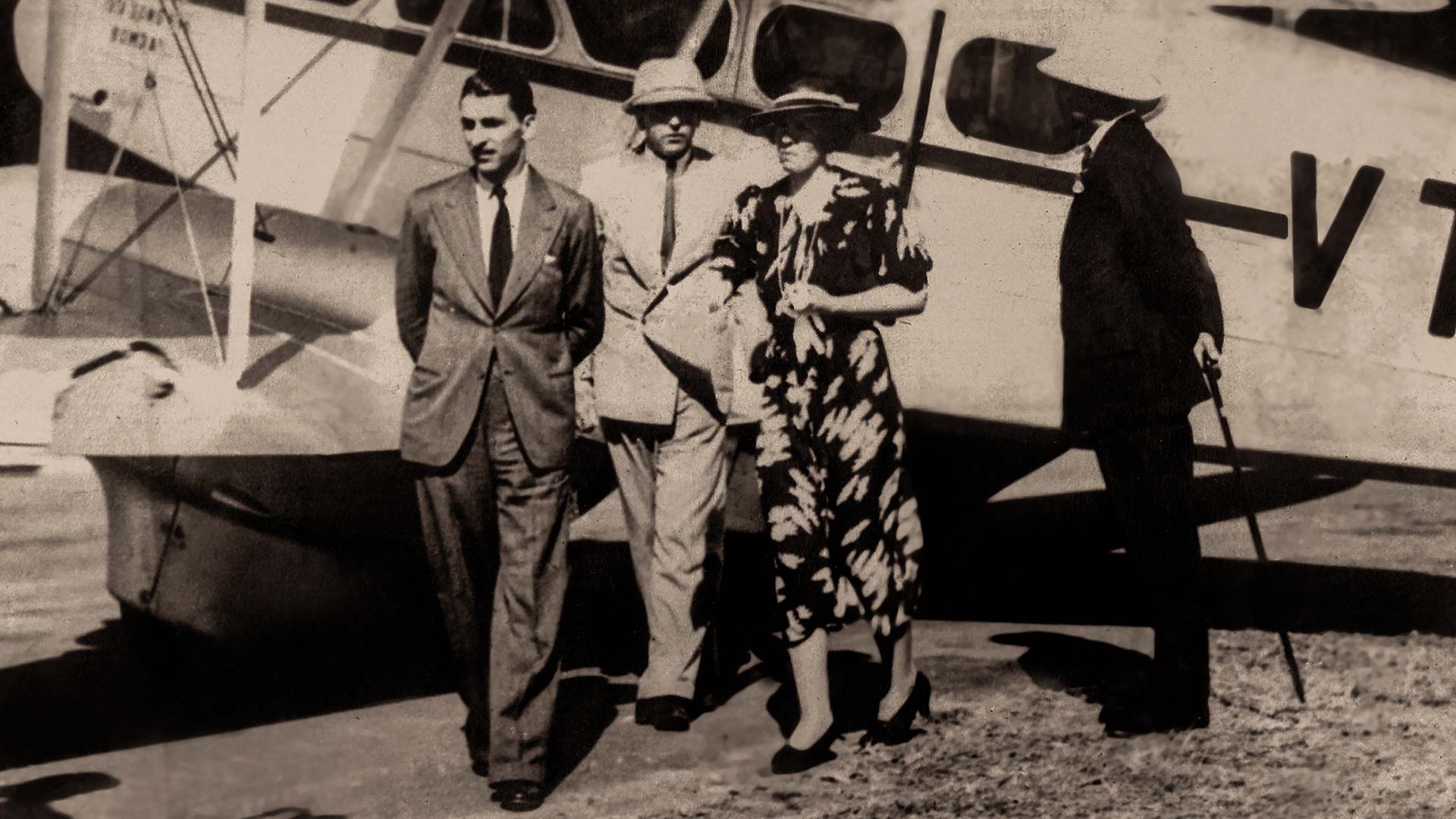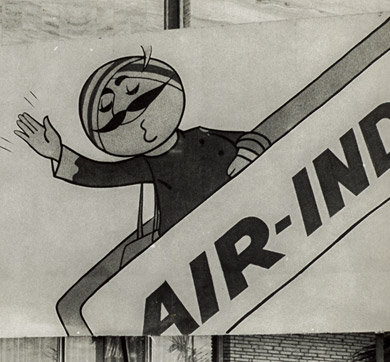January 2022 | 1909 words | 7-minute read
JRD Tata was personally in contact with the British during wartime, in connection with the manufacture of an aircraft for which a new company called Tata Aircraft was floated in March 1942.
“My devotion to aviation was not only to the airline but to aviation and aeroplanes. So when the war came along, with the help of Nevill Vintcent, we decided to offer to build up an aircraft industry that would be useful after the war. Since metal aeroplanes needed a lot of metallurgical materials and experience we couldn't import easily, we decided to offer to build the Mosquito – a light, twin-engine fighter bomber. It was made of wood and could go extremely fast. The De Havilland company built it and it was designed to carry one big bomb. It was used to bomb Berlin. We would have to import the engine, of course. The body was a fairly simple structure, very successful. The British Government said yes, and we began to build a factory in Pune near the Aga Khan Palace.”
Vintcent (pictured second from left in photo above, with — left to right — JRD Tata, Lady Lumley and Sir Roger Lumley, Governor of Bombay, while inspecting a De Havilland Rapide at Juhu, Bombay, 1937) made arrangements with various railway and other workshops in the country, and left for England in the middle of October. He stayed there for the next three-and-a-half months to make preliminary arrangements with the designing firm and the Ministry for Aircraft Production, for the purchase of materials and equipment, and to recruit staff to manufacture the Mosquito in Indian factories. So enthusiastic was he about putting this idea into action quickly that he wanted to come back to India as soon as possible to firm up details.

This was wartime and the fastest route back was to request a ride in an RAF aircraft. He did so and boarded an RAF Hudson bomber plane on January 29, 1942.
The aircraft disappeared without a trace, and there was no news of Nevill Vintcent thereafter. It is said that for some time, JRD Tata kept waiting for his beloved friend and colleague to return, but he never did.
It soon became clear that the Hudson bomber had been shot down somewhere off the coast of France. Vintcent’s body was never discovered, but the sad reality soon dawned on everyone. The man who had helped co-found India’s first airline along with JRD had disappeared off the face of the earth, at the young age of 40.
RM Lala, JRD Tata’s biographer, narrates a beautiful French quote which JRD would sometimes use: “When someone dear to us passes away, a part of us dies with him too.” This was clearly the case with JRD Tata and Nevill Vintcent. The two men had associated so closely that their bonds went beyond work alone. They had immersed themselves in creating a new industry for India – commercial aviation – a space that would soon become very important to its future.
It is said that JRD Tata kept a photograph of Vintcent on his worktable, next to a picture of his father. Undoubtedly, Jeh was fond of him, and he also respected him for all his contributions towards creating and nurturing Tata Airlines, which went on to become Air India.

While preparations were on to establish the workshop and install the machinery, the British Government cancelled the order and asked to switch to Invasion Gliders. Soon realising that it was totally unpractical, that was cancelled too.
Tata Aircraft Ltd was floated with an authorised capital of Rs 1 crore and issued capital Rs 16 lakh. Tata Sons were appointed managing agents for a period of 20 years on a commission at the rate of 10 per cent on the net profits earned with a minimum profit of Rs 12,000 per year.
In November 1942, the company was given a contract by the Government of India for (a) the construction of certain factories, and (b) for the assembly, maintenance, repair and overhaul of aircraft and engines for the air forces under the South East Asia Command. According to this contract, known generally as the CMU (Communication Management Unit) contract, as the agents of the Government, the Company had to erect and manage five units in Poona, Bombay, Dum Dum, Barrackpore and Lucknow.
Meanwhile, with the war coming to an end, the factories closed down one after the other, the last one at Dum Dum on December 31, 1946. Later, the buildings and equipment were also handed over to the various authorities as per the Government’s instructions. The factory at Barrackpore was handed over to Hindustan Aircraft Ltd, in March 1951.
JRD was excited about the post-war prospects for aviation. In November 1943, in his talk ‘The Dawn of the Air Age’ at the Bombay Rotary Club, he said: “The first and most important consequence of the arrival of the Air Age will, therefore, be to make the world one neighbourhood and to bring its people closer together physically. The next will be a tremendous acceleration in the tempo of our life. With increased opportunities for business and cultural contact, the range and number of our activities will be much greater than they are today, and we may have to make room for these increased activities by cutting out unnecessary or unproductive occupations like listening to Rotary talks!”
In less than twenty years, the Boeing 707 jet arrived and revolutionised air transport.

Under its contract with the Government, Tata Aircraft had about 1,000 men at its peak. The Government finance included not only capital expenditure but all expenditure chargeable to revenue such as wages, power, fuel, stores, etc. For its services, the company received only a management fee, the amount of which varied from time to time.
The Directors’ Report for 1945-46 describes the gradual reduction under orders of the Government of India of their programme of work owing to the cessation of hostilities. The work done by the company at various units during the war under difficult circumstances was highly praised by Air HQ South East Asia Command, who, in issuing a letter of appreciation to the Company, state:
“...Tatas were by far the largest single unit in this organisation and thanks to them, some 500 aircraft and 1,500 engines were completely overhauled and repaired and returned to squadrons for further use. In addition, many hundreds of aircraft, arriving by sea from England and America, were erected. It is no simple matter to engage and train the highly skilled personnel required to repair such a complicated structure as an aeroplane or engine. Much credit is due to Tatas for their efforts. It has been a grand achievement and the Royal Air Force and Royal Indian Air Force owe you a debt of gratitude.”

This contract with Tata Aircraft which came into force from November 1, 1942, was to continue until 12 months after the cessation of hostilities. Therefore, when the work under the CMU contract was approaching completion, Tata Aircraft entered into contract with the Government of India for the dispersal of surplus stores left behind by the US air forces operating from India. An agreement between the Government and Tata Aircraft was entered into on March 29, 1946 (signed later in 1947), appointing Tata Aircraft as agents of the Government of India for the disposal of stores from the American depots at Titaghur, Panagarh and Ramaghat (Bengal), Karachi (Sind) and Agra (UP). A few weeks later, the company was asked to take over the American depots in Assam and planes left in Allahabad and Jodhpur as also some stores from Hindustan Aircraft, Bangalore.
At its peak, Tata Aircraft had 5,481 men under the second contract.
In 1952, Tata Aircraft went into voluntary liquidation. In the course of time, Tata Aircraft Ltd became Tata Housing Development Company Ltd in 1989.
In 1951, the Defence Minister Baldev Singh offered JRD the Chairmanship of Hindustan Aircraft Ltd (HAL), Bangalore; JRD had been on the board for some years. Regretting his inability to take on the chairmanship, JRD spelled out his reasons on August 16:
“First, I do not think it is a sound principle for the head of what is, to all intents and purposes, a defence industry, to be an active businessman or industrialist.
“Second, as head of Air India, a company which has dealings with HAL, it is not desirable that the two companies should have a common chairman.
“Third, I think it is important that the chairman of the company should, as far as possible, be a resident of Bangalore or within easy reach of the management. For the chairman to be in Bombay is hardly better than for him to be in Delhi.
“Fourth, I am frankly not satisfied that there aren’t perfectly satisfactory alternatives to my appointment. I have previously recommended that Sir R Mudaliar should be appointed chairman of the company.”

JRD knew that Air India could not compete in size with well-established airlines, and he never tried. But he had the confidence that his airline’s equipment, maintenance and decor were second-to-none and that Air India could excel in the quality of its service. “I want,” he told his employees, “that the passengers who travel do not have occasion to complain. I want to establish that there is no airline which is better liked by passengers, that is safer and more punctual, where the food and service is better and which sets a better image than Air India.”
The ever-bowing Maharajah was a symbol of that service.
Sorab Kaikushroo (Bobby) Kooka created the Maharajah to give the brand, re-christened as Air India in 1946, a human face that represented India with charm and dignity
JRD Tata finally left the Board of HAL on July 14, 1961. By 1966, Hindustan Aircraft Ltd (Bangalore), with the amalgamation of the five units, became Hindustan Aeronautics Ltd – one of the largest enterprises in India. In addition to fighters, they are now building the Avro 748 and helicopters and engines. The company is now controlled by the Ministry of Defence.
JRD always wanted the Tatas to be involved in aerial transportation and manufacture of planes. His dream of aerial transportation was a grand success before the airline was nationalised and he ceased to be chairman. As far as aircraft manufacture was concerned, apart from some help rendered to Hindustan Aircraft, his ambitions were not fulfilled.

However, the Tatas more recent forays into both these sectors indicates that ‘Tata doesn’t always mean goodbye’.
Notably, the Tata group presently operates two separate joint ventures, Vistara and AirAsia India. Going forward, the group is also focused on partnering global OEMs for programmes for fighters, helicopters, transport aircraft and weapons systems supporting critical aerospace and defence programmes for the Indian defence sector, as well as setting up world-class aero engine components manufacturing facilities through its companies like Tata Advanced Systems Ltd (TASL).
With these ventures, and the recent return of Air India to the stable, the Tatas are still making strides in aviation and will continue to constantly reach for the skies.


The author, RP Narla, is archivist, Tata Central Archives.
Photographs courtesy Tata Central Archives.
Missed Part 1 of this two-part series? Read it here.



